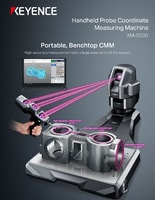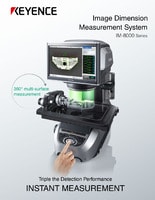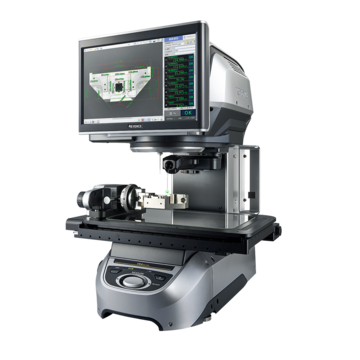Optical Comparator (Profile Projector)
What is Swiss Machining? Benefits & Applications
Are you familiar with a Swiss army knife? The specialized multi-tool gadget that comes in handy in almost any situation is known for its precision and identity as Swiss-based. Enter Swiss machining, another multi-tool, precise, Swiss-style machining invention created in Switzerland that machinists regard for its efficient, cost-effective, and precise processing ability.
When is Swiss Machining Used?
Invented in 1870 in Switzerland for watchmakers to detail the fine components of watches, Swiss machining has evolved and become a popular CNC machine across industries. These machines are similar to conventional lathe machines; however, Swiss machining uses intricate processing for parts that can be smaller than an inch, have a movable headstock, use a high-pressure coolant system, and have live tooling for rotating between tools.
Swiss-style machining uses Computer Numerical Control (CNC), guide bushing, and bar stock altogether for efficient and precise production. It works by using guide bushing and headstock to stabilize the bar stock while the machine shapes it into slots, holes, threads, and diameters. These finalized pieces have a high-quality finish that is achieved efficiently and precisely. Swiss machining is used when manufacturers want to create a large production of small or slender parts.
We’re here to provide you with more details.
Reach out today!

The Capabilities of Swiss Lathe Machining
Swiss lathe machining is commonly known for its capability of working with precision, but there are many other capabilities beyond that. Let’s dive into what Swiss machining is, its benefits, as well as other notable capabilities.
Swiss Lathe Machining Processes Precisely
No matter who manufactures with a Swiss lathe machine, they’re guaranteed to be precise. These machines can work on components or parts that are less than an inch in size. Some Swiss lathe machines can process components as small as 12 mm or less in diameter. Because of this precision, manufacturers in tightly regulated industries like aerospace or the medical device industry trust that any Swiss lathe machine will ensure precision.
Swiss Lathe Machining Processes Quickly
Swiss lathe machine processing time varies by machine, but they generally can produce over 30 parts per hour. Also, since multiple tools on Swiss lathe machines allow them to mill, drill, ream, and saw, the processing time is used more efficiently. A Swiss lathe machine can work on components with multiple processing needs instead of using multiple conventional lathe machines for one component.
Swiss Lathe Machining is Used on a Range of Materials
Swiss lathe machining is versatile enough to use on a wide range of materials, such as:
- Aluminum
- Bronze
- Brass
- Copper
- Hastelloy
- Monel
- Steel
- Stainless steel
- Titanium
Swiss Lathe Machining Saves Money
The smaller tooling and multi-tool use by Swiss lathe machining is the main reason why it’s so cost-effective. Because the tooling is so intricate, it can create multiple parts from one sheet rather than wasting an entire sheet on one part. Additionally, components requiring multiple processing techniques can all be done with one Swiss lathe machine instead of having to use multiple. Because multiple parts can be made instead of one, it’s more cost-effective.
Swiss Lathe Machining Creates Less Waste
As mentioned, less waste is created because multiple parts can be made from one unit. But, there is also less waste because there is less of a possibility of a production error.
When using a conventional lathe machine on intricate parts, a processing error will likely occur either by human fault or by the machine tooling being too large. Because intricate parts are usually used in industries with strict regulations, one small mistake could be detrimental to the entire product and cause the whole part to be discarded. Using a Swiss lathe machine reduces these errors, which creates less waste.
Contact us to learn more about how our advanced technology can help take your business to the next level.
Contact Us
What Industries Can Benefit from Swiss Lathe Machining?
Many industries benefit from Swiss-style machining since it is a versatile process that excels at processing a range of small materials.
Here is a list of just a few industries that are utilizing this machining:
- Aerospace
- Automotive
- Chemical
- Construction
- Dental
- Electrica
- Marine
- Musical instruments
- Medical devices
- Nuclear
- Oil
Since Swiss lathe machining spans across so many industries, there are many different components that these machines work on. Some examples include:
- Connectors
- Pins
- Sockets
- Fuel injectors
- Valves
- Screws
- Firearm barrels
- Dental brackets
- Mirrors
- Bolts
Although Swiss-style machining is used across all of these industries, the two industries that benefit the most from Swiss lathe machining are aerospace and medical devices.
Medical Devices
The medical device industry is known for intricate tools and equipment. Especially recently, as medical device innovation becomes smaller and more personalized for patients, these devices must fit strict regulatory standards for the best patient outcomes. Some examples of devices that Swiss lathe machines may process include:
- Cutters
- Implants
- Prosthetics
- Saws
- Clamps
- Scissors
- Heart rate monitors
- MRI scanners
- X-ray scanners
- Tubes
- Catheters
- Bone screws
Since some of these devices will be inserted into the human body for a perfect fit in replacement of an actual human body part, they need to be the exact precise size, which is why Swiss-style machining is used. Swiss-style machining has unbeatable accuracy, with some machines boasting remarkable precision.
Aerospace
In the aerospace industry, Swiss machining is used for complex components for aircrafts, using processing methods like turning, milling, and deburring. Some examples of components that Swiss lathe machining for the aerospace industry are:
- Valve seat
- Machined reflector
- Aileron pulley cover housing
- Door hatch stop
- Control valve housing
- Connectors
- Fittings
We’re here to provide you with more details.
Reach out today!

Future of Swiss Lathe Machining
Swiss lathe machining has proven to be efficient, precise, and cost-effective for over two centuries. This multi-tool machine with a moving headstock is a must-have for all industries, especially aerospace and medical devices. The intense precision of Swiss lathe machining facilitates the production of intricate components that meet the industry’s strict regulatory guidelines.
Looking forward, Swiss lathe machine manufacturers predict more advancements in Computer Aided Design/Computer Aided Manufacturing (CAD/CAM) software integrated into Swiss lathe machines. To further support the growth and advancement of Swiss machining industry, KEYENCE’s Optical Metrology Solutions help engineers design better design components, production teams increase machine up-time and more efficiently manufacture, and meet the highest-level of quality control standards. The IM Series Automated Optical Comparator and LM-X Series Multisensor Measurement System enables users to accurately measure hundreds of dimensions in seconds at the push of a button. Beyond their GD&T, CAD comparison, and thread inspection capabilities, automated rotary indexer allow for 360-degree inspection for consistent alignment and difficult measurements like through holes/slots and runout.
Related Downloads

Brochure for the XM-5000 Series Handheld CMM. Portable CMM to easily and accurately measure 3D and GD&T features anywhere including the shop floor and in the machine tool.

Brochure for the IM-8000 Series Image Dimension Measurement System. Accurately measure parts in seconds at the push of a button.


![YOUR GUIDE TO ADVANCED MEASUREMENT TECHNIQUES [New Common Measurement Practices]](/img/asset/AS_116631_L.jpg)

